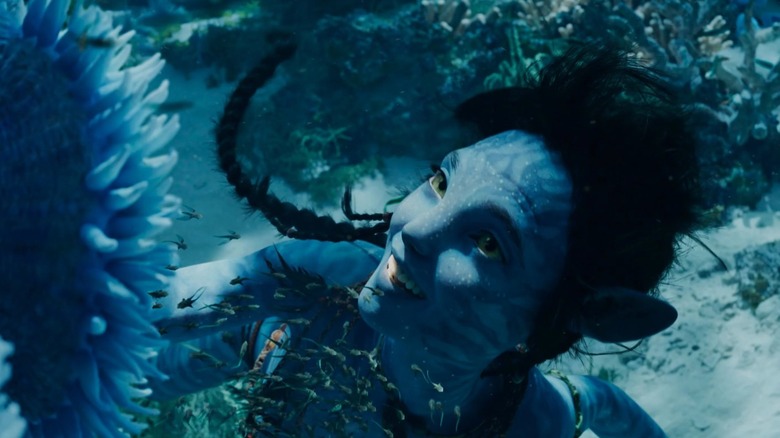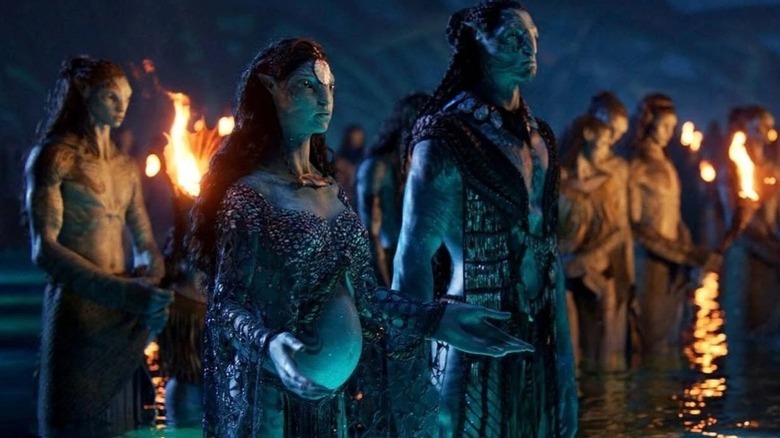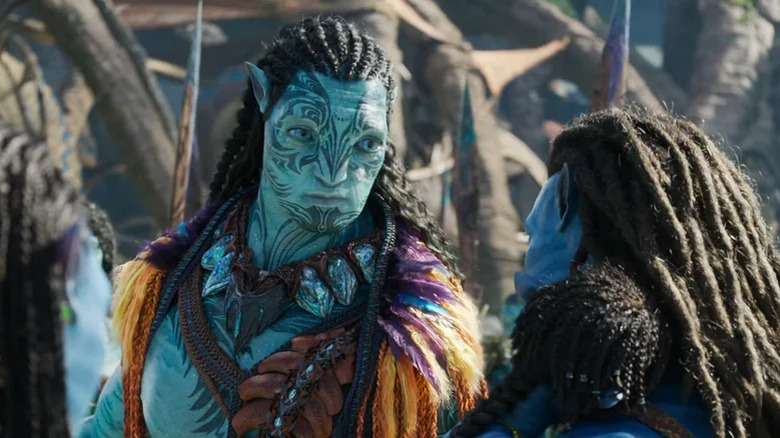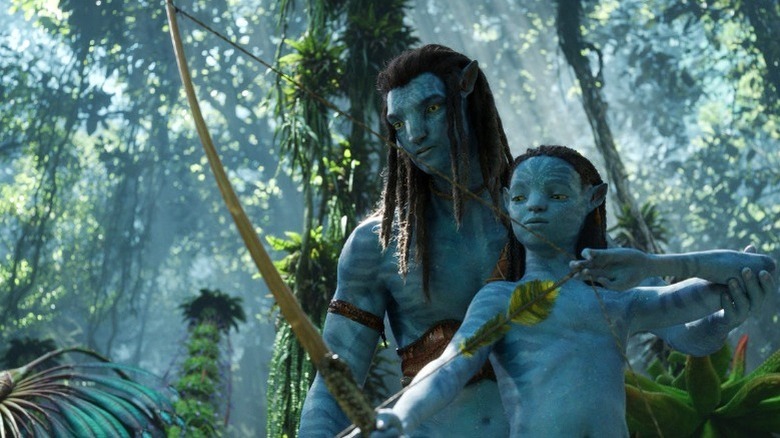How Avatar: The Way Of Water Is Pushing Blockbusters To The Next Level
It's that time of year — when studios release their big hitters, awards bait, and prestige dramas, and when every outlet releases their top 10 movies of the year lists too early. That's because both studios and top 10 lists tend to underestimate that last major blockbuster that gets released towards the very tail end of the year, the movie that's being sold as just entertainment, but ends up delivering rather complex and resonant stories. Last year, that movie was "The Matrix: Resurrections" and this year, the biggest release of December is without a doubt James Cameron's "Avatar: The Way of Water."
After 13 years, we are finally about to return to Pandora with a movie that suffered multiple delays and has a ludicrously high budget. Still, one should never bet against James Cameron, the man who gave us the highest-grossing film of all time not once, but twice; the filmmaker responsible for the 3D craze of the 2010s. Now, Cameron and the Na'vi are back with a film that is huge in every sense of the world — a movie that needs to be one of the most successful films ever just to break even, a movie with a story so big it needs multiple sequels to even scratch its surface. "Avatar: The Way of Water" is taking blockbuster filmmaking to the next level.
A technological marvel
The first "Avatar" was a marvel of visual effects. Before the "Planet of the Apes" reboot trilogy gave us entire armies of realistic simians, and before Marvel Cinematic Universe started replacing costumes with motion-capture pajamas, "Avatar" used motion-capture and VFX wizardry to deliver a vast world that felt real and lived-in, creatures you could almost touch, and a movie so realistic people got depressed because Pandora wasn't a place they could visit.
For the sequel, the filmmaker is going bigger. "The Way of Water" brings Cameron's love of the ocean and deep sea exploration to Pandora, as this becomes the first film to shoot motion-capture performances underwater. According to Cameron, it took a year and a half just to solve the problem of shooting the underwater scenes, and they threw "a lot of horsepower, innovation, imagination and new technology at the problem" in order to fix it. This is a big deal because it removes space limitations of motion-capture just like the "Planet of the Apes" reboot trilogy did by shooting scenes outdoors. It also led to Kate Winslet breaking Tom Cruise's record of holding his breath underwater.
But it's not just the technology that is bigger this time around, it's the story. "Avatar: The Way of Water" is set to kickstart an epic generational family saga centered around Jake Sully, Neytiri, and their children. It's why this movie needed to be so long, because "the emphasis in the new film is more on character, more on story, more on relationships, more on emotion," according to Cameron. We're not just expanding the Sully family, but seeing more Na'vi tribes with both cultural and physiological differences, teasing new relationships that may carry on the Sully name across the decades.
A very expensive family epic
In a way, "The Way of Water" aims to tell the kind of story with an epic scope we're used to seeing on TV these days rather than film — a multigenerational story planned out from the beginning. We even know where the story ends, kind of. The Pandora section of Disney World is canon to the films and is set a century after the war between Na'vi and humans is over, with humans welcomed once again in Pandora. Whether we reach that point in the films remains to be seen, but James Cameron doesn't rule out making more "Avatar" movies beyond the current plan of four sequels, even if it requires him "to train somebody how to do this because, I don't care how smart you are as a director, you don't know how to do this."
And "Avatar: The Way of Water" has a runtime to match its scope. For a movie all about bodies of water, about people swimming underwater, about underwater creatures, and with the word water in the title, it feels a bit ill-advised that the runtime for "The Way of Water" is 3 hours and 10 minutes, just four minutes shorter than "Titanic."
But before you start complaining, uncle Jim Cameron is here to tell you to shut up and soak it up. For one, JC knows you spend longer than that binging shows on Netflix. And if you need to go to the bathroom, then by all means go ahead, even Cameron is all for it, "it's okay to get up and go pee," he said in an interview. But what about the scenes you miss while you pee? Jimbo doesn't care, in his words, fans "can see the scene they missed when they come see it again."
Too big to fail
In order to bring such a big vision to life, Cameron and his team are sparing no expense, really. Just look at how the trailers look, and how big everything about "Avatar: The Way of Water" feels. You'd think Cameron was changing his name to John Hammond.
It all starts with the film's budget, which is just astronomical. When asked just how expensive his sequel's budget was, Cameron coyly answered "Very f***ing," before going on to call the film "the worst business case in movie history." Really, much like how "The Rings of Power" was just too big to fail and had the entire Amazon Studios' future depending on its success, so does "The Way of Water" have an impossible threshold to meet before it becomes successful. According to Cameron, "you have to be the third or fourth highest-grossing film in history. That's your threshold. That's your break even." Now you see why he wants you to go to the bathroom and watch the film again for the scenes you missed. This may be the worst business case in movie history, but we are thankful to the studio for their sacrifice.
Now, before you start talking about cultural relevancy, it's important to remember we're talking about "Avatar," a movie that makes millions every time it is re-released. We're talking about a franchise that gave people depression because they wanted it to be real. And you should never bet against Gen-Z. For many people who watched the first "Avatar" when they were kids, Cameron's film became their "Star Wars," their first big sci-fi franchise that introduced them to a brand new world full of possibilities. Waiting 13 years for a sequel has only made anticipation higher, and if the success of "Top Gun: Maverick" proved anything is that a long wait between films doesn't mean anything if the sequel is entertaining and not belonging to a tired franchise.



